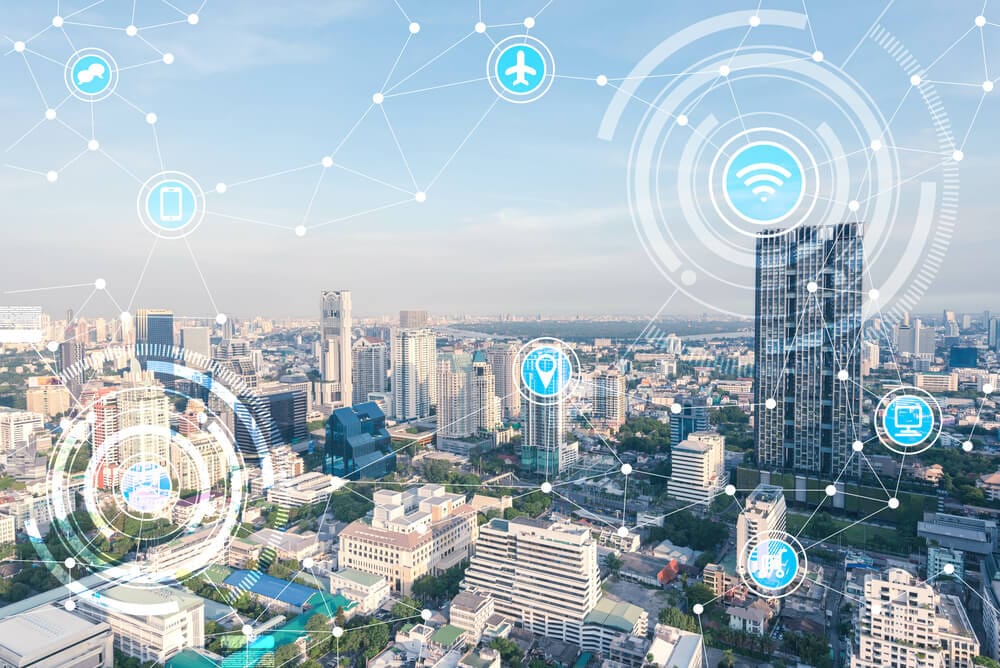Real-Time Traffic Monitoring and Adaptive Routing
Every minute spent in traffic adds up, leading to wasted time, higher fuel consumption, and more pollution. With IoT, cities can monitor and adjust road conditions in real time. Instead of relying on fixed traffic patterns, roads can adapt dynamically based on actual conditions.
How does this work? It starts with a network of sensors and cameras placed across the city. These devices collect data on vehicle flow, congestion levels, and road incidents. The data is then processed by AI-powered traffic management systems that can instantly recommend alternative routes for drivers. This helps in:
- Reducing congestion by redirecting cars before bottlenecks form.
- Allowing emergency vehicles to reach their destinations faster.
- Optimising public transport routes based on traffic patterns.
Navigation apps already use some IoT data, but the benefits multiply when cities integrate IoT-WorkS technology into their infrastructure. Vehicles are more evenly distributed across roads, preventing unnecessary delays. Additionally, real-time accident detection instantly alerts authorities, reducing response times and minimising further disruptions.
Smart Traffic Lights for Optimised Flow
Traffic signals are essential for managing intersections, but traditional systems operate on pre-set schedules that do not always match real-time road conditions. Smart traffic lights solve this problem using IoT sensors to adapt to traffic flow.
These smart signals adjust dynamically instead of changing lights based on fixed timers. If one road is packed with cars while another remains empty, the system can extend green light durations to improve movement. The benefits include:
- Shorter waiting times for drivers and pedestrians.
- Reduced congestion at busy intersections.
- Better coordination between traffic signals across the city.
Emergency services also benefit. Smart lights can detect approaching ambulances or fire trucks and prioritise them by adjusting signal timings. This technology is already used in some cities, significantly reducing emergency response times.
Public transport can also be prioritised. Buses and trams equipped with IoT devices can communicate with traffic lights, ensuring they get priority at intersections. This makes public transport more reliable, reducing delays and encouraging more people to use buses and trams instead of private cars.
Smart traffic lights help lower fuel consumption and emissions by improving traffic flow and reducing unnecessary stops. Driving becomes smoother and more efficient when cars do not have to stop and start frequently.
Smart Parking Systems to Reduce Road Congestion
A major cause of city congestion is drivers’ searching for parking. This can take several minutes in busy areas, leading to unnecessary traffic buildup. IoT-powered parking solutions help by providing real-time updates on available spaces, making parking faster and easier.
How do these systems work? Cities install sensors in parking spots that detect whether a space is occupied. This data is sent to a central system, which drivers can access through mobile apps or digital signs. The key advantages include:
- Drivers spend less time searching for parking.
- Reduced traffic caused by unnecessary driving.
- More efficient use of available parking spaces.
Some cities have even introduced automated parking systems that guide cars into free spots without human intervention. This saves time and improves parking efficiency by eliminating gaps between vehicles.
Smart parking also benefits businesses. If people know they can easily find parking near shops or restaurants, they are more likely to visit. At the same time, parking operators can use data to adjust pricing based on demand, making parking more efficient for drivers and city planners.
Connected Vehicles and Communication Between Road Users
IoT-WorkS enables real-time communication between vehicles and infrastructure, enhancing road safety and efficiency. Vehicle-to-vehicle (V2V) and vehicle-to-infrastructure (V2I) technology allows instant data exchange, improving traffic flow.
Here’s what it enables:
- Vehicles can send signals to each other about sudden braking or potential hazards.
- Roadside infrastructure can provide real-time updates on accidents or road conditions.
- Traffic lights can adjust timings based on incoming traffic volume.
For example, if a car detects icy road conditions, it can alert nearby vehicles, helping them adjust their speed in advance. Similarly, connected cars can instantly relay this information to others if an accident occurs, preventing further collisions.
Cities also use IoT to improve pedestrian safety. Smart crosswalks can detect people waiting to cross and adjust traffic signals accordingly, ensuring safer crossings and efficient vehicle flow.
By integrating connected vehicle technology with IoT traffic control, cities can improve road safety and prevent congestion before it even happens. This makes driving more predictable and reduces frustration for all road users.
IoT in Public Transport for Better City Mobility
Efficient public transport is essential for reducing private car use and improving overall traffic flow. IoT helps make buses, trains and trams more reliable by providing real-time updates and route optimisation.
Here’s how it improves public transport:
- GPS tracking allows passengers to see exact arrival times, reducing wait times.
- Buses and trains can adjust routes dynamically based on traffic conditions.
- Digital signs and apps provide live updates on delays and alternative routes.
For operators, IoT-based vehicle tracking enables predictive maintenance, reducing breakdowns and disruptions. Additionally, smart ticketing solutions using IoT allow seamless, contactless payments, speeding up boarding and improving efficiency. By integrating IoT-WorkS technology, cities can make public transport more attractive, reducing congestion and enhancing urban mobility.
